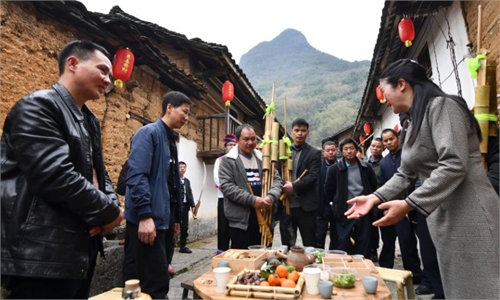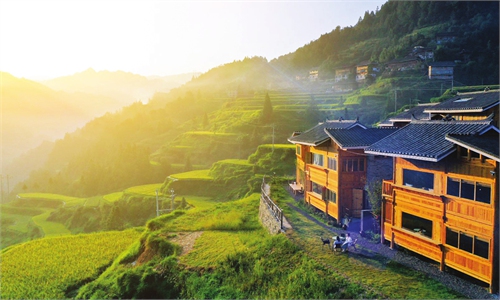Tiger painting industry lifts a small village called Wanggongzhuang to prosperity
Residents' diligence, skill and tenacity earn them a good life

The tiger, one of the Chinese zodiacs, whose mighty power and spirit are broadly adored in the country, has the implied meanings of power, courage, wisdom and physical health - used for "dispelling evil" in traditional Chinese culture.
A small village, which has a population of just 1,300, in Central China's Henan Province, one of the most populous provinces in China, has found fame for its residents' special technique used in painting tigers.
In Wanggongzhuang village under Minquan county in Shangqiu, Henan Province, about 70 percent of residents are in the business of painting, and naturally the village was named as "China's No.1 village of tiger painting." Many painters are often from the same family. Siblings, couples, parents and the children paint together.
Wanggongzhuang's tiger painting business, with sales exceeding 100 million yuan ($14.55 million), has become the pillar industry of the village's economy. Their unique painting skills have earned them the strong competitiveness for tiger painting in the domestic and international markets.
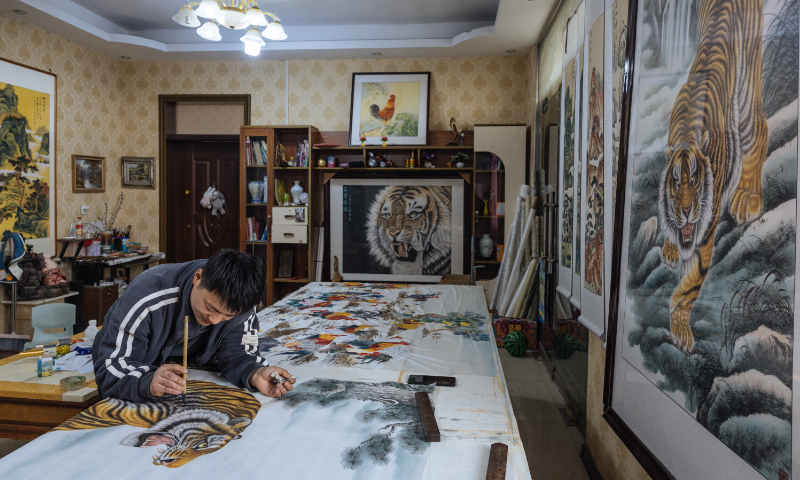
A resident in Wanggongzhuang, Central China's Henan Province, paint a tiger. Photo: Li Hao/GT
Distinctive industry
Unlike other villages in the region that earn income through farming activity, Wanggongzhuang's budding art industry is quite different.
Wanggongzhuang's paintings are themed primarily about tigers, and sometimes the villagers paint flowers, birds, fish, and insects too. About 90 percent of local painters schedule their activities based on market demand. And, up to 40 percent of their paintings are exported to countries and regions such as Japan and Bangladesh, as well as China's Hong Kong and Macao special administrative regions.
In order to support the positive development of local painting industry, relevant authorities have formed painting co-operatives, focusing on e-commerce and livestreaming sales.
In 2021, painters in Wanggongzhuang produced more than 90,000 paintings, which generated up to 100 million yuan of sales revenue, while livestreaming sales recorded 200,000-yuan daily sales, a local official told the Global Times.
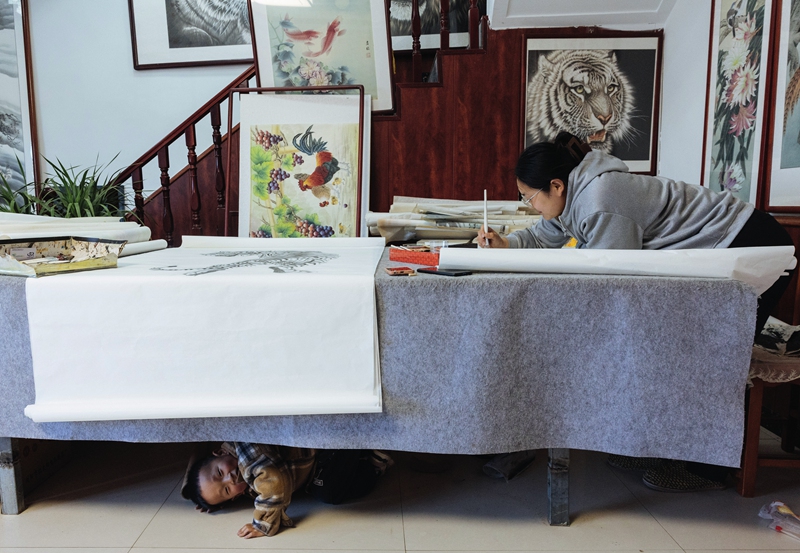
A resident in Wanggongzhuang, Central China's Henan Province, paint a tiger while her child hides under the table. Photo: Li Hao/GT
Zhao Quanxi, a young painter who was born in 1988, studied painting tigers from 14. Now his tiger painting is being sold at a price of 3,500 yuan each square foot. He said that most of his clients would like to customize a tiger painting rather than buy a finished painting with fixed tiger image.
Zhao explained that different elements of tiger painting, such as tiger's movement climbing up or down a mountain and the color of tiger's fur have different implied meanings in Chinese culture.
"I would communicate with my client in advance to get to know the tiger in their mind, and try my best to bring them onto the paper," Zhao told the Global Times, noting that a tiger painting may need at least one week or several months to complete.
After four decades development of the local tiger painting industry, a professional sale agents' team with about 20 members has been set up in the village to sell tiger paintings to customers from Beijing, Shanghai and South China's Guangdong Province and even overseas market, Zhao noted.
"There once was a painting vendor from the US who was attracted by tiger paintings, eventually the vendor bought 5 million yuan worth of tiger paintings in total from the village and resold them back in his country," said Zhao.
Wanggongzhuang is currently making effort to train young painters to sustain the artistic crafting into the future. Some renowned painters including Zhao have their training class available for locals and people in surrounding villages and neighboring counties.
Zhao is also in touch with painting lovers in South Korea, Canada and the US. They had lived in Wanggongzhuang for months to learn local painting skills.
Road to prosperity
As to market competitiveness of Wanggongzhuang's tiger paintings, Zhao believed local artists' earnest work and innovation have played a vital role. He displayed a special painting brush with only two to three millimeters of hair at the top, which was crafted by some tiger painting pioneers, and the technique was later spread to arm all painters in the village.
The unique painting brush can make the tiger fur more fluffy and vivid. Tiger painters also choose the quality Xuan paper, a traditional Chinese paper that has less ability of absorbing water and suitable for gongbi painting, a genre of Chinese painting that depicts subjects as lifelike through detailed strokes and complicated dyeing techniques.
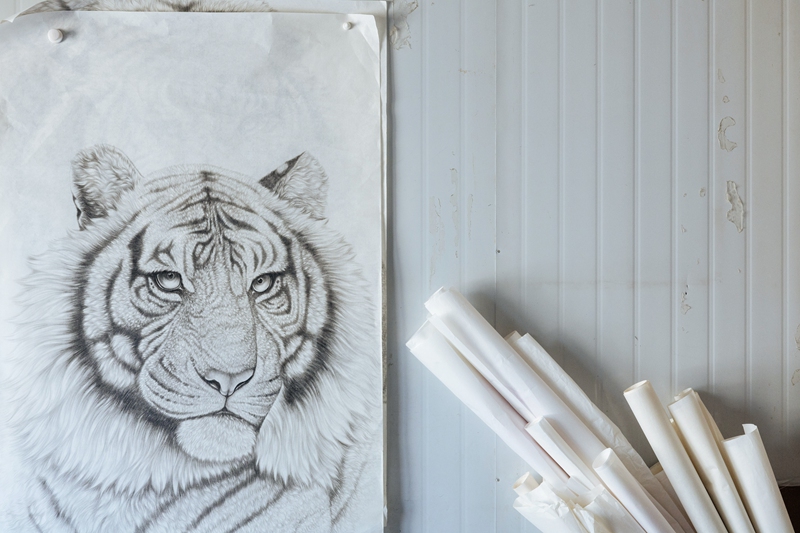
A portrait of a tiger painted by a resident in Wanggongzhuang, Central China's Henan Province. Photo: Li Hao/GT
Considerable revenue generated by tiger paintings is luring more villagers to pursue the paint brush instead of farming tools, as they are trekking another road to prosperity.
Wang Jianwei, another local painter, is operating a painting studio with three painters including himself. Wang told the Global Times that some simple tiger paintings can be completed within a week and be sold at about 5,000 yuan.
"The development of local painting industry has helped me to earn more money for my family," said Wang.
Wanggongzhuang is located at a highland near the old path of the Yellow River, the drought and difficulty of water diversion seriously restricted the production of local agricultural sector.
Xiao Yanqing, a pioneer of Wanggongzhuang's tiger painting industry, told the Global Times that local authorities had hired well-known painters to the village to teach residents painting skill, which propels growth of local tiger painting business, noting that the support from local officials also assisted tiger painting.
China in February unveiled the No.1 central document targeting the high-quality development of country's rural area, which vowed to foster different types of industries such as tourism and services and e-commerce to boost income of local people.
In Wanggongzhuang, locals have refurbished buildings and streets of the small village so as to attract more tourists. And, the residents there all believe that the spirit of tiger will inspire them to do more creative things.
